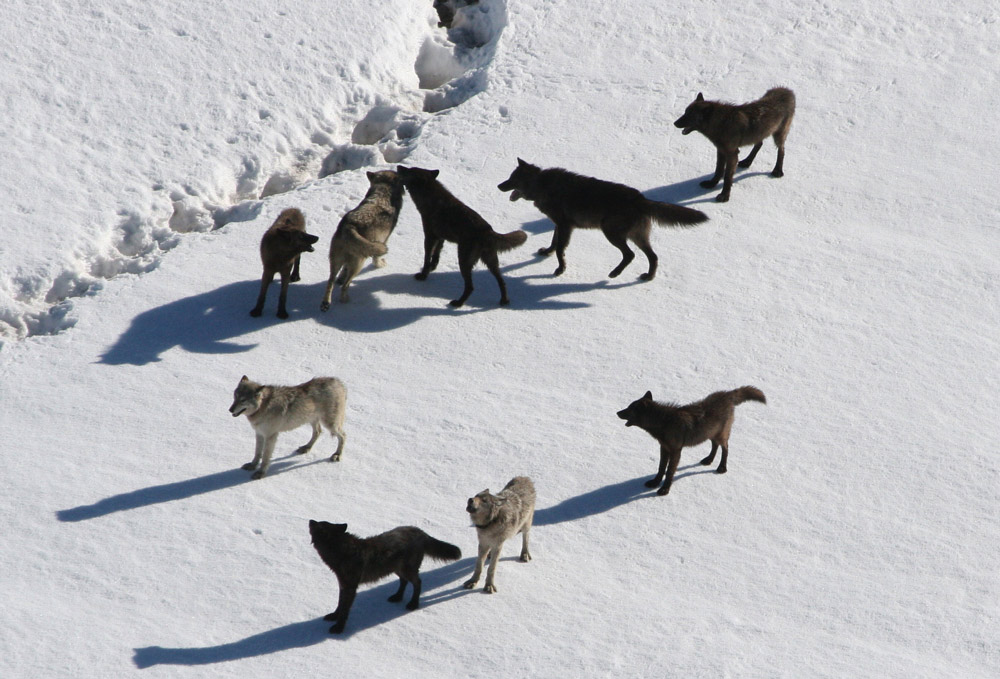 The
restoration of wolves to the Yellowstone area will be featured in the
slide presentation “Wolves: A Keystone Species in the Greater
Yellowstone Ecosystem” at 7:00 p.m. Thursday, May 14 at the Oakhurst
Methodist Church. The public is welcome to this free program. Photo credit: Wikimedia.org
The
restoration of wolves to the Yellowstone area will be featured in the
slide presentation “Wolves: A Keystone Species in the Greater
Yellowstone Ecosystem” at 7:00 p.m. Thursday, May 14 at the Oakhurst
Methodist Church. The public is welcome to this free program. Photo credit: Wikimedia.orgSteven Sage, a teenage student with a passion for wolves and experience in Yellowstone-area wolf research, will share his knowledge and love for these iconic animals at the May program of the Yosemite Area Audubon Society. Sage will present a slide show, “Wolves: A Keystone Species in the Greater Yellowstone Ecosystem,” at 7:00 p.m. Thursday, May 14, at the Oakhurst Methodist Church on Road 426 in Oakhurst.
Wolves once roamed North America from the Arctic to Mexico, but by the early 1900s, loss of habitat and wanton extermination had extirpated them from most of their range, including Yellowstone National Park. The National Park Service (NPS), established in 1916, systematically removed predators from their native habitats under its misbegotten policy of protecting elk and other “benign”prey species from predation by eliminating the predators that had ecologically regulated the numbers in prey populations.
In 1973 the U. S. Fish and Wildlife Service listed the northern Rocky Mountain gray wolf as an endangered species under the provisions of the then-new Endangered Species Act and designated the Greater Yellowstone Area as one of three wolf recovery areas. About that same time the NPS officially changed its wildlife management policies, recognizing that balanced natural systems are ecologically healthier and more sustainable than manipulated systems that favored individual species and led to overpopulations.
From 1995 - 1997 the NPS and other federal agencies reintroduced 41 wild wolves from Canada and Montana into Yellowstone National Park. Wolf packs soon dispersed into adjacent areas, making them more vulnerable to human-caused mortality, but the park continues to offer assurance of long-term viability of the population and opportunities for research.
Sage’s presentation will offer insights on this reintroduction of gray wolves into the Greater Yellowstone Ecosystem. His presentation will cover gray wolf biology, history, extermination, reintroduction and current conservation status. “Now more than ever,”he says, “it is essential for environmentally aware citizens to be educated about this issue. Wolves are a keystone species that need to be protected in order to benefit the greater good of the ecosystem.” He will also discuss the political issues generated by the presence of wolves in the Rockies and the methods being used to protect the species and sustain the agricultural economy of the Rocky Mountain West.
A native of Lander, Wyoming, Sage has been immersed in and passionate about nature since a young age, thanks of his father, a teacher. He is now trying to pass on his passion for the natural world to young people and adults alike. He spends his summers hiking in northwest Wyoming with his rescue dogs and has participated in three formal wolf research projects southeast of Yellowstone National Park. He is currently collaborating with a local land trust to educate the public about the need for conservation and protection of wild lands in the Sierra Nevada foothills. He plans to attend the University of Alaska Fairbanks and eventually earn a doctorate in biological sciences.
Like all YAAS programs, Sage’s slide talk is open and free to the public, although donations to defray program costs and to support Audubon’s local activities are welcome.
The YAAS will also offer its monthly field trip Saturday, May 16, to Foresta in Yosemite. Participants will meet at the Midpines County Park on Highway 140 at 7:45 a.m. to carpool. The trip is free and the public is welcome. Bring binoculars, field guides, food and beverages. Wear comfortable, waterproof walking shoes.
Call (209) 742-5579 or (209) 966-2547 or visit: yosemiteaudubon.org for more information about the program or the field trips.
The mission of the National Audubon Society, the namesake of noted 19th-century naturalist and bird painter John James Audubon; its state affiliate, Audubon California; and local chapters such as the Yosemite Area Audubon Society is to conserve and restore natural ecosystems, focusing on birds, other wildlife and their habitats for the benefit of humanity and the earth’s biological diversity.
Article contributed by Len McKenzie
source


No comments:
Post a Comment